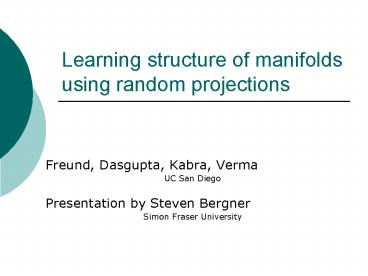Learning structure of manifolds using random projections - PowerPoint PPT Presentation
1 / 34
Title:
Learning structure of manifolds using random projections
Description:
Data matrix Xi,j of coordinates. Row i=1..N is data sample ... Compression also possible when going to projection coordinates. My interest: ... – PowerPoint PPT presentation
Number of Views:298
Avg rating:3.0/5.0
Title: Learning structure of manifolds using random projections
1
Learning structure of manifolds using random
projections
- Freund, Dasgupta, Kabra, Verma
- UC San Diego
- Presentation by Steven Bergner
- Simon Fraser University
2
Structure
- Definitions and problem setting
- Related Work
- Random projections trees
- Results
3
Data
- Data matrix Xi,j of coordinates
- Row i1..N is data sample
- Column j1..D is attribute or dimension
- Challenges
- Large N storage, streaming, sampling
- Large D insufficient training data
- Undefined fields graphical models
4
Manifolds
- Every point has an Rn neighborhood
- Global structure may be different
Chinese Swiss roll
source wikipedia
Earth
5
Dimension
- Extrinsic
- Number of measurements
- (Non-)linear dependencies
- Intrinsic
- Data near d-dimensional manifold dltD
- Independent, uncorrelated
- E.g. doubling dimension
6
Distributions with low intrinsic d
- Example Motion capturing
- D markers each with 3 coordinates
- Body posture determined by joint angles
7
Related work
8
(Non-)parametric statistics
- Parametric
- E.g. fitting a Gaussian to observations
- Needs a model
- Non-parametric
- E.g. estimating a histogram (density)
- Bayesian statistics
- Manifold learning
- Needs lots of examples
- Framework Approximation theory
9
Manifold learning
- Incrementally grow neighborhoods
- Locally-linear embeddings Roweis Saul 2001
- Wi,j weights of local neighbors to reconstruct
point i - Embedding coordinates in first eigenvectors of
Wi,j - ISOMAP Tenenbaum et al. 2001
- Build k-nearest neighbor graph
- Shortest path lengths between all points in
matrix A - Eigenvectors of A provide embedding coords
10
Random projections
- Johnson-Lindenstrauss 83
- Classifier capacity with random projections Garg
2002 - Compressive sensing Candes 2006
11
Johnson-Lindenstrauss Lemma
- Target dimension k does not depend on original
dimension d
DasguptaGupta 99
12
Random projection trees
13
Kd-trees
- BSP
- Used for nearest neighbor queries
- Associative memory
14
RP-trees
- Split along random directions
- Split point minimized inner-cell variance
15
Algorithm Make Tree
- S is point set
- Rule(x) divides the set
16
Algorithm PCA choose rule
- Sorting along random direction v will give
similar median
17
Point set diameters
- Diameter of S
- maxx-y for all x,y in S
- Average diameter
18
Algorithm RP tree choose rule
- Split minimizes inner-class variance
19
Building an RP tree
- PCA Ellipsoid for comparison only
- split now chosen via RP rule
20
Building an RP tree
21
Building an RP tree
22
Building an RP tree
23
Building an RP tree
24
Building an RP tree
25
Split diameter Theorem
- Covariance dimension d(?) fulfils
- For a cell C split into several C
26
Proof for doubling dimension d
- A cell of diameter ? may be covered by O(dlogd)
balls of radiuslt?/2 - Those can be split with O(dlogd) projections
27
Streaming implementation
- Fixed set of random directions v chosen at
beginning - Use v that minimizes avg. diameter
- Both splits operate on projected pts.
- Statistics updated for each node
28
Results
29
Results (synthetic data 1)
Data set 1 10,000 points in 1000-dimensional
unit cube randomly perturbed by Gaussian noise
with sigma1
30
Results (synthetic data 2)
Data set 2 10,000 points chosen equally from
two 1000-dimensional Gaussians at (1,..,1) and
(-1,,-1)
31
MNIST data Handwritten digits 1
32
MNIST data Handwritten digits 1
33
MNIST data Handwritten digits 1
34
Applications
- Description of manifold may be used for
classification, interpolation - Compression also possible when going to
projection coordinates - My interest
- VC-dimension and discrepancy
35
Thank you for your attention.
- Questions?































